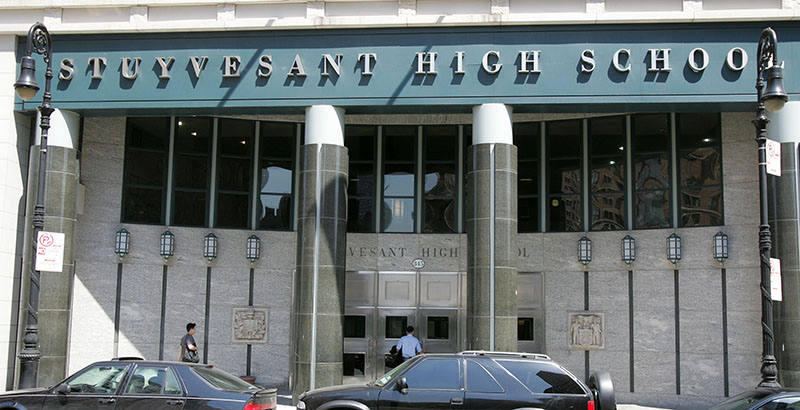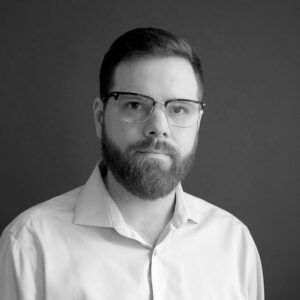Race-Blind or Discriminatory? NYC’s Plan to Diversify Elite High Schools Becomes Latest Fodder for Advocates Seeking Supreme Court Rollback on Affirmative Action

Speaking at a suit-and-tie gathering at the Harvard Club in midtown Manhattan, attorney John Yoo offered a message to New York City’s mayor and schools chancellor that could only be described as cocky: Thank you.
Yoo was grateful for city officials, he said, for presenting “a case that’s going to be so easy for us to win.”
The Manhattan Institute, a conservative think tank, arranged the recent gathering to rally behind a new federal lawsuit against Mayor Bill de Blasio’s efforts to diversify eight of the city’s specialized high schools — elite, selective public institutions that have produced Nobel laureates and Pulitzer Prize recipients. Though race-neutral on their face, the changes were designed in a way that discriminate against Asian-American students, the lawsuit alleges. Asian-American children currently make up about 16 percent of New York City’s public student population but 62 percent of those enrolled at the selective schools.
Several comments by de Blasio and Chancellor Richard Carranza, the lawsuit alleges, demonstrate that the changes were devised to “racially balance” the schools “by decreasing the percentage of Asian Americans who may attend” in favor of black and Hispanic students who have long filled few seats on the selective campuses.
“Government has gotten very clever using race,” said Yoo, a law professor at the University of California, Berkeley, who is perhaps best known as an author of the “torture memos” that advised the George W. Bush administration on “enhanced interrogation techniques” such as waterboarding after the Sept. 11, 2001, terrorist attacks. In Manhattan, Yoo railed against school diversity plans that don’t explicitly mention race but are designed to benefit people of specific races.
Proving discriminatory intent, however, can be daunting, he said.
“But thankfully, your mayor and your schools chancellor love to prove the hard parts of the case for us,” Yoo said to laughter from the audience. The Pacific Legal Foundation, a libertarian law firm from California that’s long worked to dismantle affirmative action policies, filed the suit in December. Plaintiffs in the case include Asian-American parents, a parent teacher organization, the Chinese American Citizens Alliance of Greater New York, and the Asian American Coalition for Education. Though Yoo doesn’t represent the plaintiffs, he sits on Pacific Legal’s board of trustees.
Just days after Yoo’s comments, however, a federal judge told a different story. The judge presiding over the suit, filed in the Southern District of New York, denied a request to halt de Blasio’s changes, noting that Pacific Legal was unlikely to prove that city officials acted with discriminatory intent. While the kind of injunctive relief de Blasio’s critics sought is rare, the judge did not mince words. Changes central to the Pacific Legal lawsuit, the judge said, “are exactly the sort of alternative, race-neutral means to increase racial diversity that the [Supreme Court] has repeatedly suggested governments may use in lieu of express racial classifications.”
But Yoo implied that Pacific Legal has a bigger venue in mind: the U.S. Supreme Court.
At the Manhattan club, the Harvard University alum offered a tongue-in-cheek plea that his alma mater not kick him out of their posh establishment. Harvard, like the New York City Schools, currently faces a lawsuit in which Asian-American families allege the institution’s admissions process is discriminatory. But unlike the Harvard case, which centers on a race-conscious policy, the lawsuit in New York City goes a step further — challenging a race-blind policy designed to promote greater diversity.
“The Supreme Court, in a way, allowed this to happen,” Yoo said. “It went the wrong way, and now they have the chance to fix it.”
Big discovery
The share of white and Asian-American students who fill the classrooms of New York City’s specialized high schools has long outpaced their representation across the city’s highly segregated public schools system. Meanwhile, black and Hispanic children make up roughly 70 percent of the city’s student population but only about 9 percent of those admitted to the elite schools. This past school year, just 10 black students were offered spots at the most competitive campus, Manhattan’s Stuyvesant High School, out of 902 offers.
Despite years of efforts by the de Blasio administration to diversify the campuses, the disparities have persisted. But in June, the mayor announced a series of controversial reforms designed to create greater diversity.
One proposal would eliminate the Specialized High School Admissions Test (SHSAT), a standardized test for rising eighth-graders and the sole factor in selecting students to the elite institutions. Instead, the mayor wants to offer admittance to high achievers from every middle school across the city. That proposal, however, comes with a hitch: Eliminating the test would require state policymakers to table a law that’s been in place since the 1970s — an idea that’s likely a nonstarter in Albany.
The second change — one that is at the center of the Pacific Legal lawsuit — centers on eligibility requirements for the “Discovery” program, a summer course for low-income students who fell just shy of passing the SHSAT. The plan expands the size of Discovery to account for 20 percent of all specialized high school students. Eligibility requirements for Discovery, however, are further restricted. Under the new rules, only low-income students who attend high-poverty schools are eligible, a change the city estimates will result in greater geographic, racial, and socioeconomic diversity. The city projects that 16 percent of admissions offers will be awarded to black and Hispanic students, up from roughly 9 percent currently.
In defending the proposals, de Blasio called the specialized high school student demographics a “monumental injustice,” though he also noted a lack of geographic representation. At the Bronx High School of Science, for example, just 14 percent of students reside in the borough. Citing the concerns of some Asian-American parents, a reporter asked Carranza whether the proposed changes pitted “minority against minority.” “Absolutely not,” Carranza responded. “And I just don’t buy into the narrative that any one ethnic group owns admission to these schools.”
But a boost in black and Hispanic student enrollment, Pacific Legal contends, will come at the expense of Asian-American youth. In the complaint, the group used the comments by de Blasio and Carranza against them. Those statements, attorneys argued, showed the city is discriminating against Asian-American students in violation of the Fourteenth Amendment’s equal protection clause.
The mayor’s proposals prompted a flurry of support and outrage. Alumni associations from several selective high schools blasted the changes, while some parents accused de Blasio of racism. Other observers warned that the changes could result in “dumbing down the schools.”
During the Manhattan Institute event, Wai Wah Chin, president of the Chinese American Citizens Alliance of Greater New York, called the plan the “Asian Exclusion Act of this century.” Though some argue that the SHSAT is racially biased, she objected. She also pushed back on the assertion that the specialized schools aren’t diverse, since Asians represent a myriad of cultures, languages, and religions spread across more than half of the world’s population.
“Don’t call us all the same, because that’s pretty discriminatory,” Chin said. Chin’s group is one of the plaintiffs in the Pacific Legal lawsuit. Joshua Thompson, an attorney at Pacific Legal who represents the plaintiffs, called the Discovery program changes a “racial proxy.” Officials chose to gear the program toward low-income students at high-poverty schools, he said, “because of its racial impact, because it will produce this racial result.” Meanwhile, he challenges the assertion that diversifying K-12 schools represents a compelling government interest.
Taking a far different outlook was Stuyvesant’s 2018 valedictorian, Matteo Wong, who endorsed the changes during his graduation speech. “The same caliber students can be found elsewhere, if we would only look through a different lens,” he said.
Also backing de Blasio’s plan is Richard Kahlenberg, director of K-12 equity and a senior fellow at the Century Foundation, a progressive think tank. Given the adverse effects of attending a high-poverty school, it’s reasonable for New York City officials to center the Discovery program on students in that environment, he said.
A large body of research has found that students from low-income households struggle academically compared with their more affluent peers, especially children who attend high-poverty schools. In a 2010 study on students in Montgomery County, Maryland, researchers found that children in public housing performed far better academically if they attended a higher-income elementary school compared with those enrolled at high-poverty campuses.
“It’s deeply unpopular to explicitly consider race — and there are legal problems with explicitly considering race — but that’s not what New York City did in this instance,” Kahlenberg said. “They looked to the socioeconomic status of the school that a student is attending, and that’s perfectly legal and is much more politically palatable than looking at race.”
Meanwhile, research has pointed to the educational benefits of racial integration. Vulnerable students who attend integrated New York City schools experience a “modest benefit” to educational attainment compared with children in the most segregated schools, according to a 2017 report by New York University’s Metropolitan Center for Research on Equity and the Transformation of Schools.
The report’s co-author Metropolitan Center Executive Director David Kirkland said research shows a “tale of two school systems” in New York City, featuring campuses of privilege alongside those with concentrated vulnerability. Changes to Discovery, he said, recognize the systemic injustice black and Hispanic students experience.
“That won’t correct the system,” Kirkland told The 74, but “it will begin to create a level of support within that system to mitigate against some of the biases that it has against particular students.”
The high court
Back at the Harvard Club, Yoo spoke with confidence and flair. This time around, he predicted, the Supreme Court would be more favorable to his position.
With Justice Anthony Kennedy gone from his perch as the Supreme Court’s pivotal swing vote, Yoo saw a clearer path to victory. It was Kennedy who, in 2016, cast the decisive vote to uphold an affirmative action admissions process at the University of Texas at Austin. In a 2007 Supreme Court decision, Parents Involved in Community Schools v. Seattle School District No. 1, the majority found that school districts in Seattle, Washington, and Louisville, Kentucky, violated federal law when they used race to assign students to schools, but recognized a compelling government interest to promote diversity in schools.
Kennedy retired from the Supreme Court last year, his vacancy filled by Justice Brett Kavanaugh.
“I would be very surprised to see Justice Kavanaugh vote to uphold the use of race in the Harvard case or this case or other cases that are coming up in the system,” Yoo said. “To the extent that the court personnel has changed, it’s probably going to become more conservative on race. I would say conservative color-blind on race issues.”
In denying Pacific Legal injunctive relief, Edgardo Ramos, the Obama-appointed federal judge in New York, relied on a concurrence by Kennedy in Parents Involved to argue that race-neutral policies to promote diversity are permissible.
Ramos said the plaintiffs will likely fail to show the city had discriminatory intent in amending the Discovery program. With the changes to Discovery allowed to move forward, a city Department of Education spokesman told The 74 it plans to announce in March students admitted to a specialized school through the test.
“We are excited to move forward with the expansion of the Discovery program,” spokesman Doug Cohen said in an email. “Our schools are academically stronger when they reflect the diversity of our city.”
Reflecting on the lawsuit, Jin Hee Lee, senior deputy director of litigation at the NAACP Legal Defense and Educational Fund (LDF), said she isn’t concerned that the Supreme Court will take a sharp turn to the right on diversity efforts in schools — or that the justices would take up the case. The LDF represents student and alumni organizations in the Harvard lawsuit and, in 2012, filed a complaint with the U.S. Department of Education alleging that segregation in New York’s specialized high schools violates federal law. That complaint is still pending.
She said she’s confident the Supreme Court will uphold the city’s changes to Discovery because they’re race-neutral. The equal protection clause, she said, protects people who have historically faced discrimination and expands their access to opportunities.
“That’s exactly what the Discovery program does,” she said, “and to say that in itself is discrimination is really turning the very term ‘discrimination’ on its head.”
Meanwhile, Thompson of Pacific Legal was decidedly more measured in his estimation of the case’s chances than Yoo. He was unwilling to wager that the Supreme Court makeup would be more favorable to his arguments — or that a trip to the high court will be necessary. He said he’s disappointed the judge was skeptical of his allegations while denying the preliminary injunction, but he’s preparing for a long haul — not an easy win.
“We are committed to fighting for these Asian-American students in New York,” he said. “This was just the first battle of a long war.”
Get stories like these delivered straight to your inbox. Sign up for The 74 Newsletter

;)
